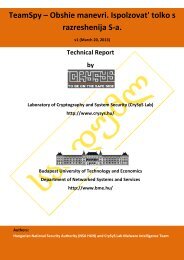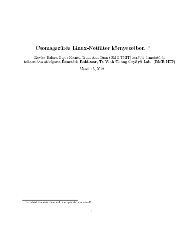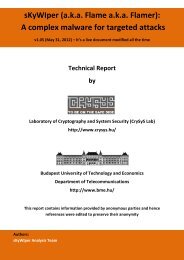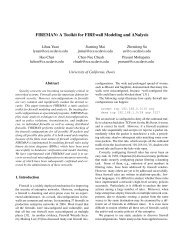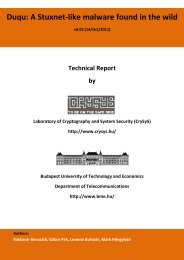You also want an ePaper? Increase the reach of your titles
YUMPU automatically turns print PDFs into web optimized ePapers that Google loves.
Chapter 3<br />
Location Privacy in Vehicular Ad Hoc<br />
Networks<br />
3.1 Introduction<br />
In this chapter, I investigate what level of privacy a driver can achieve in Vehicular Ad Hoc<br />
Networks (VANET). More specifically, in the first half of this chapter, I investigate how can a local<br />
eavesdropping attacker trace the vehicles based on their frequently sent status information. In the<br />
second half of this chapter (from Section 3.4), I go a little further in terms of strength of attacker,<br />
and check what can a global eavesdropping attacker do. After realizing its broad capabilities, I<br />
suggest an algorithm, which can greatly reduce the attackers success rate.<br />
Recently, initiatives to create safer and more efficient driving conditions have begun to draw<br />
strong support in Europe [COM], in the US [VSC], and in Japan [ASV]. Vehicular communications<br />
will play a central role in this effort, enabling a variety of applications for safety, traffic<br />
efficiency, driver assistance, and entertainment. However, besides the expected benefits, vehicular<br />
communications also have some potential drawbacks. In particular, many envisioned safety related<br />
applications require that the vehicles continuously broadcast their current position and speed in<br />
so called heart beat messages. This allows the vehicles to predict the movement of other nearby<br />
vehicles and to warn the drivers if a hazardous situation is about to occur. While this can certainly<br />
be advantageous, an undesirable side effect is that it makes it easier to track the physical location<br />
of the vehicles just by eavesdropping these heart beat messages.<br />
One approach to solve this problem is that the vehicles broadcast their messages under pseudonyms<br />
that they change with some frequency [Raya and Hubaux, 2005]. The change of a pseudonym<br />
means that the vehicle changes all of its physical and logical addresses at the same time. Indeed, in<br />
most of the applications, the important thing is to let other vehicles know that there is a vehicle at<br />
a given position moving with a given speed, but it is not really important which particular vehicle<br />
it is. Thus, using pseudonyms is just as good as using real identifiers as far as the functionality of<br />
the applications is concerned. Obviously, these pseudonyms must be generated in such a way that<br />
a new pseudonym cannot be directly linked to previously used pseudonyms of the same vehicle.<br />
Unfortunately, only changing pseudonyms is largely ineffective against a global eavesdropper<br />
that can hear all communications in the network. Such an adversary can predict the movement of<br />
the vehicles based on the position and speed information in the heart beat messages, and use this<br />
prediction to link different pseudonyms of the same vehicle together with high probability. For<br />
instance, if at time t, a given vehicle is at position ⃗p and moves with speed ⃗v, then after some short<br />
time τ, this vehicle will most probably be at position ⃗p + τ · ⃗v. Therefore, the adversary will know<br />
that the vehicle that reports itself at (or near to) position ⃗p + τ ·⃗v at time t + τ is the same vehicle<br />
as the one that reported itself at position ⃗p at time t, even if in the meantime, the vehicle changed<br />
29



